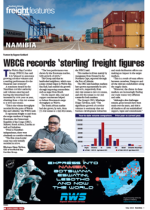While the container terminal at the Port of Walvis Bay is running well below capacity – at about 25% of its 750 000-TEU capability – it’s expected that the takeover of port operations by Terminal Investment Limited (TIL) will bump up volumes significantly.“And it needs to be done sooner rather than later,” says the Namibian shipping stalwart and managing director of Novaship Namibia, Willie Prosser.“We’re sitting with a beautiful container terminal at the moment, but where’s the cargo? The sooner TIL takes over from Namport (Namibian Ports Authority), the better it will be for everyone.”But the expected private-sector involvement of the Mediterranean Shipping Company subsidiary is not a panacea for the port’s volume woes.Up north in Angola, another multinational ports operator, DP World, has received concession approval from the government of President João Lourenço to run all five of the country’s ports, from Namibe in the south to Cabinda in the north.Most importantly, it includes the Port of Lobito, the closest exit point for copper and cobalt mined in ore-rich areas like Kolwezi in the Democratic Republic of the Congo (DRC).Should logistical collaboration between Angola and the DRC come to fruition, bulk freight volumes by rail could hamper Namibia’s hopes of securing the lion’s share of outf lows to the west of the Copperbelt.“It’s a real concern as it could become major competition for Walvis Bay,” Prosser says.“It’s no secret that the corridor we have to the Copperbelt (via Katima Mulilo into Zambia) is very important for the port to increase volume and revenue.“But from what I know, there are infrastructural issues on the line to Lobito, especially in the DRC. Corruption and the difficulty of working in some of these countries are part of the problem.”Prosser says long-prevailing issues such as cost, safety, and the fickleness that the Port of Lobito is known for, becoming easily congested and prone to disruption, will most likely be to Walvis’s benefit.“Shippers might feel that it’s better to pay a premium but be secure than to take a gamble with what’s happening, not only on the line to Lobito, but at the port itself.“Compared to unexpected challenges that at any time could arise in countries like Angola and the DRC, Namibia offers stability and surety.”Whatever DP World and other private-sector parties accomplish up north through processes and procedures, it may take years before the results take root, says Prosser.He emphasises, though, that the threat to Namibia’s ambitions to become a leading transit hub for regional logistics by 2030 isn’t necessarily without but within.Referring to the transhipment service from Lüderitz to Walvis Bay that Maersk and Ocean Africa Container Lines cancelled, forcing cargo from the southern port to be moved by road up north, Prosser says it was a major mistake.“We could have had more cargo at Walvis had it not been for that decision. We had a competitive advantage through transhipping, but Namport and others dropped the ball.”He says it’s regrettable that there’s a perception of immaturity among public sector executives, who don’t seem to know what they’re doing.“Our political leaders need to learn what it really takes to help private-sector players make better use of facilities like the terminal at Walvis Bay.“Sometimes you get the idea they are not talking to one another. You only need to look at the departments of immigration, agriculture and transport to see that many trade barriers can be avoided.”

